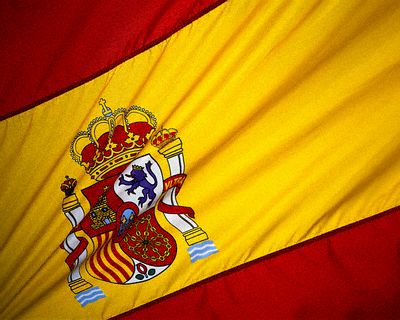THE ATTRACTIONS OF THE REGION
http://www.murciaciudad.com/
http://www.ayto-cartagena.es/
http://torreviejafiestas.com/
http://www.alicante.es/
LA MANGA DEL MAR MENOR is distinguished from other Spanish resorts by a higher number of sunny days – 315 during the year. The temperatures does not fall below 15 centigrade in January and February and they are often over 20 centigrade.
The swimming season starts in the middle of March and finishes in the middle of December. It is the most beautiful and interesting coast in Spain. The Mediterranean Sea is the warmest because the cold ocean currents do no get here.
The World Health Organization classified the climate in the area as one of the healthiest in the world. As well as this, the environment is highly recommended for health treatments. The European Union marked the cleanness of water and the beach with the “Blue Flag”.
Mar Menor offers the biggest outdoor mud treatment in Europe. The mud is easily absorbed and increases the capacity of skin of absorbing the minerals. It also stimulates treatment of those affected with bone problems. The mud application is recommended for skin diseases, rheumatism, throat infections, rehabilitation and others.
Health treatments with salty water are worth trying as they enhance beauty, help to relax, remove cellulites and take away the stress.
Salt concentration combined with the appropriate temperatures contributed to the creation of a microclimate which is recommended by physicians specialized in the field. The area is known for its health properties, supporting the treatment of heart diseases. The application can be compared to rheumatologic and bronchial tubes treatment. Having a bath in a salty mud is also helpful and is a perfect treatment for those suffering from arthritis and dermatological diseases.
MAR MENOR is a shallow sea which makes it a paradise for swimmers and water sport fans. It is a perfect place for learning. Shallow water is very safe for children and the temperature exceeds 30 centigrade during the summer season. This makes La Manga a perfect holiday resort for the families with small children.
There is plenty of entertainment for children all around the place: from playgrounds to theme parks.
Pubs, night clubs, cafes, restaurants, shopping centers, recreational areas and beautiful marinas are located alongside the town.
The shopping center DOS MARES with a cinema and numerous shops is located on the other side of the bay http://www.centrodosmares.com/
Being lucky, one can watch aerobatics show at the San Javier airport located also on the other side of the bay. Not only do the airliners take off from the airport but also military aircraft performing blood-curling maneuvers.
TOWNS
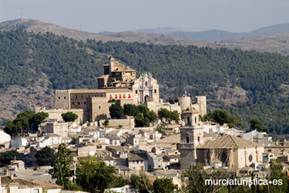
While staying in La Manga peninsula, it’s worth to see on of the seven Holy Towns - Caravaca de la Cruz with a Sanctuary, where there is a famous wood relic from the Jesus Christ crucifix called the Cross from Caravaca de la Cruz.
According to the legend, a priest could not perform the church service in the year of 232 because he did not have a crucifix. At that very moment two angels brought him the crucifix.
The truth, however, is somehow different, the Templar coming back from one of the crusades, brought the splinters from the Jesus Christ crucifix and put them into a cross-shaped reliquary.
The cross miniatures can be bought everywhere as well as cross-labeled, “holy” wine and local sweets called yemas (balls of candid yolk in caramel or chocolate).
It is good to know that numerous and marvelous fiestas await the tourists. The greatest last from the first until the fifth of May and includes Caballos del Vino (included in UNESCO list).
The main events held during these days are horse races. The horses come beautifully decorated and are assisted during the race by four men. There are three different competitions organized: the beauty of the horse is awarded on the first of May, the competition to run up the hill is held on the second of May and the decorations of horses are assessed on the third of May. The prize is satisfaction and fame.
We also recommend seeing Cartagena, where apart from the city’s numerous monuments, there are remains of the Roman amphitheatre and well-preserved part of the Punic wall, dated back to the 3rd century before the Christ. It is worth visiting the caves with prehistoric paintings which were put on the UNESCO list of cultural heritage. The heart of the city is the pedestrian area extending to the Town Hall alongside Calle Mayor. We recommend seeing the real prototype of the submarine and many beautiful yachts in the seaport.
The best panoramic view extends from the fortress Castillo de la Concepcion. One can learn a lot about the complicated local history while visiting the museum located in the fortress.
It is worth coming to Cartagena in the middle of September where the famous fiesta „Carthaginians vs. Romans” is held. Over 5,5 thousand people take part in the open air events acting either as Carthaginians or Romans.
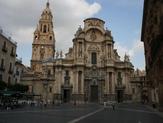 The biggest city of the region is almost 400-thousand capital Murcia.
The biggest city of the region is almost 400-thousand capital Murcia.
The city used to be famous for its silk weaving and the remains of the business can be seen in mulberry trees, essential for breeding silkworms. If a baby girl was born into a family, the father used to plant a mulberry tree. However, the 16th century cathedral is the most touristy place. The sarcophagus of the Spanish King Alfonso X of Castile is found there.
It’s good to come to see the cathedral in the evening when it is beautifully lit and atmospheric concerts are organized around.
Museo Salzillo is the most important one among all the museums with the sculptures of a famous artist of Murcia, Francisco Salzillo. There are over 1800 sculptures of the artist and terracotta figures from the Christmas crib are exposed there in the first place, as well as giant pasos, sculptures carried during the Easter procession.
 Elche is located 20 km from the sea and around 20km from Punta Prima. Elche is mostly famous for palm forests, planted by the Moors. The forests surround the city. Until today it is one of the main industries for the city. Female trees give dactyls and male trees offer their leaves for the amulets against the thunderstorms and for the palm trees constructed on the Palm Sunday.
Elche is located 20 km from the sea and around 20km from Punta Prima. Elche is mostly famous for palm forests, planted by the Moors. The forests surround the city. Until today it is one of the main industries for the city. Female trees give dactyls and male trees offer their leaves for the amulets against the thunderstorms and for the palm trees constructed on the Palm Sunday.
The most beautiful trees are grown in Huerto del Cura. While staying in the neighborhood it is a must to see the palm forest – which is really unique in Europe.
![[Lorca+catedra+0.1.jpg]](gfx/opis_clip_image008.jpg) Visiting Lorca brings a lot of unforgettable experience. The main square is Plaza de Espana, with a baroque facade Town Hall building, the Court Palace and St. Patrick Collegiate Church. There is also a water tap, usually omitted by the tourists. Water has been supplied from the neighboring “Spring of the Enamored”, commemorating two unlucky lovers whose parents did not allow for the marriage. She was a Catholic and he was a Muslim. The desperate lovers climbed the highest mountain and fell into the abyss. The water spurted out in that place.
Visiting Lorca brings a lot of unforgettable experience. The main square is Plaza de Espana, with a baroque facade Town Hall building, the Court Palace and St. Patrick Collegiate Church. There is also a water tap, usually omitted by the tourists. Water has been supplied from the neighboring “Spring of the Enamored”, commemorating two unlucky lovers whose parents did not allow for the marriage. She was a Catholic and he was a Muslim. The desperate lovers climbed the highest mountain and fell into the abyss. The water spurted out in that place.
If we want our love to last forever, we must drink this water necessarily.
However, the most interesting stories from Lorca are related to the Whites and the Blues, the fraternities who operates round the year but are especially active during Easter. Each fraternity organizes the procession, competing in the area of costumes.
Membership in the fraternity is very important. If a marriage does not belong to the same fraternity, they get separated during the week before Easter, and the friends pretend not to recognize one another if they are from a different fraternity. The fraternities have their own anthems, symbols and meeting places. St. Patrick Collegiate Church is reserved for the Whites and St. Francisco Church is for the Blues (you won’t find any white flowers there).
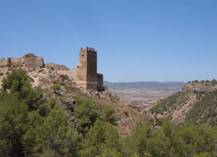 Sierra Espuna is located in the area of Lorca. This is the highest mountain in Murcia (1585 m). We can find winter wells while walking the mountain routes. They are a dozen meter deep and serve to store the snow collected in winter. They used to substitute fridges.
Sierra Espuna is located in the area of Lorca. This is the highest mountain in Murcia (1585 m). We can find winter wells while walking the mountain routes. They are a dozen meter deep and serve to store the snow collected in winter. They used to substitute fridges.
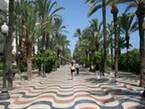 Alicante is famous for its seaside boulevard with palm trees and plenty of cafes, restaurants and shops. It is a lovely town with an ancient fortress Castillo de Santa Barbara on top of the mountain. It is said to be the landmark for the city and one of the biggest fortress in Spain, located on the rocky slopes of the mountain Benacantil. You can enjoy the spectacular view of the city and seaport. The fortress Castillo de San Fernando dates back to the 19th century and is like the continuation of the first fortress. It is located on the neighboring hill of Tossal. You will get the view of San Juan beach, the main swimming area for the city, just next to the yacht harbor. Hundreds of tourist and local citizens, longing for the sunshine, lie in the beach there.
Alicante is famous for its seaside boulevard with palm trees and plenty of cafes, restaurants and shops. It is a lovely town with an ancient fortress Castillo de Santa Barbara on top of the mountain. It is said to be the landmark for the city and one of the biggest fortress in Spain, located on the rocky slopes of the mountain Benacantil. You can enjoy the spectacular view of the city and seaport. The fortress Castillo de San Fernando dates back to the 19th century and is like the continuation of the first fortress. It is located on the neighboring hill of Tossal. You will get the view of San Juan beach, the main swimming area for the city, just next to the yacht harbor. Hundreds of tourist and local citizens, longing for the sunshine, lie in the beach there.
Iglesia da Santa Maria (Holy Mother Church) is one of the main tourist attractions, it was built in the gothic style at the turn of the 14th and the 16th century. The masterpieces of the sacral art from the 15th century can be found inside as well as baroque style naves. It is worth to see the local Town hall building called by local people Ayuntamiento. This wonderful baroque building has two twin towers that are 35 meter high. Beautifully decorated chambers and a chapel are found inside.
Alicante, the most interesting seaside city, needs to take care of its reputation. It organizes plenty of different kinds of entertainment. Numerous concerts, street parties and festivals are held all year long.

